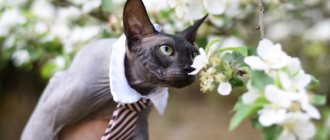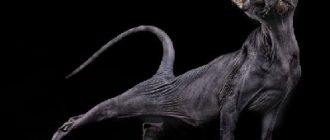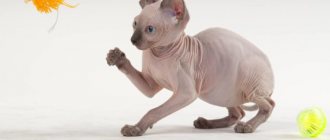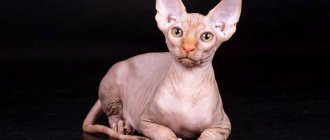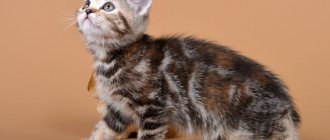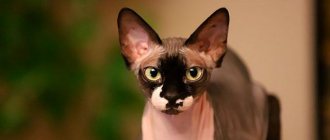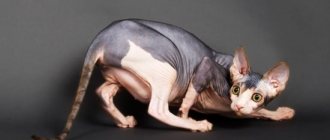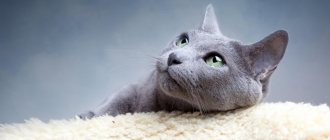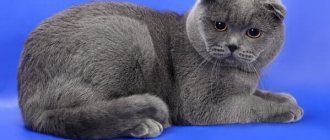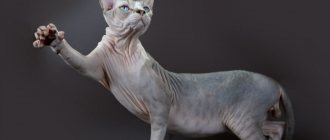The Sphynx cat is a unique breed; despite its somewhat repulsive appearance, these cats have a kind of magic and magnetism. They differ from other breeds in that they lack hair.
It is believed that the Sphynx is one of the oldest cat breeds. During the reign of the ancient Egyptian pharaohs, it was a revered and sacred animal. Hairless Egyptian cats were lost to history, but their species was revived in Canada about 60 years ago.
How the Sphynx breed was developed
Hairless Sphynx cats got their name from the famous mythical guardian of the pyramids because of their appearance. Attracting a whole range of eyes, they have gained incredible popularity among feline fans. But few people know that the breed was first mentioned many years ago in ancient papers. These exotic creatures were sacred.
Today, there are several breeds of Sphynx cats, which create one type of hairless cat. The breed of Canadian cats without fur appeared at the moment when an inconspicuous cat gave birth to a hairless kitten. After numerous studies, it was discovered that a special gene was inherited, which in turn is responsible for the lack of hair.
The Don breed of hairless cats was also discovered by chance. They tried to cure the cat, which was found on the street, for a long time, but it turned out that the pet was completely healthy. Her offspring were also distinguished by their lack of hair from other cats.
After some time, as a result of crossing the Don breed and a shorthair cat, a new line of the genus of all St. Petersburg hairless cats arose.
The history of breeding velor sphinxes
All types of hairlessness of the Don and St. Petersburg Sphynxes are based on the dominant Hbl gene, which determines the main characteristics of these breeds and their breeding. Velor wool covering is one of the most popular - it looks impressive and does not create big problems in maintenance.
Velor Sphynx kitten is an incredibly charming creature
Don Sphynx velor
The Varvara cat, with whom the Don Sphynx breed is believed to have begun, was velor-point according to the modern classification of coat and blue-cream “tortoise” according to the color type. This strange kitten was taken from the boys on the street by Rostov resident Elena Kovaleva in 1986 - and at that very moment she entered the history of felinology. She was very sorry for the “shabby” baby and tried to fatten her and cure her. The cat grew up and felt great, but there was even less hair on her.
Varvara's children also had a velor covering; a baby named Chita attracted the attention of Elena’s friend Irina Nemykina, who later became the founder of the Don Sphynx breed, making titanic efforts to develop and recognize it. The new breed was recognized by the WCF in 1998, after which it received recognition from other felinological organizations around the world. Until 2000, matings with Siberian and European shorthair cats were allowed.
This is what the modern Don Sphynx looks like
The Donchaks have several breed standards, the differences of which are insignificant. Velor Don Sphynxes are characterized by hot, wrinkled skin with a delicate coat of hair that creates a small collar around the head. Young animals may have excessive hair. In winter, the growth also increases. The vibrissae are convoluted and break off easily.
The WCF and SFF standards allow all colors, while the IFF standard prohibits lilac and chocolate. The colors of the eyes, nose and fingertips should be in harmony with the main color.
Velor Peterbald
In the group of sphinxes, this breed is the youngest; it was the result of interbreeding of Donchak with Orientals, which gave its representatives a unique appearance. The first experimental mating took place in 1994, and the offspring lived up to the wildest hopes - excellent material was obtained for further selection. Today, interbreed matings between St. Petersburg and Don Sphynxes are prohibited. The breed received international recognition from the WCF in 2003.
The Peterbald's elegant appearance contributes greatly to its popularity.
The WCF standard allows any colors for St. Petersburg Sphynxes, but the preferred eye color is green, and in color-point varieties - blue. The skin of a velor Peterbald is flexible, very delicate, the quality of wool velor is the same as that of the Don Chaks; The presence of vibrissae is highly desirable. The color of the finger pads and nose should be in harmony with the main color.
Description and general breed standard
The Sphynx cat is naturally endowed with a slender and, not surprisingly, strong and muscular body. The main difference is, of course, the skin, which has no hair or barely noticeable cover.
It is a mistake to assume that all representatives of this breed are bald - the Sphynx with hair is not new for a long time.
What also makes the Sphynx stand out is its large, slightly pointed, erect ears and almond-shaped eyes. The head is diamond-shaped. The nose is straight and flat. In general, such an elegant muzzle is a bit reminiscent of unearthly creatures. The slender, flexible body flows smoothly into long limbs and a straight, thin tail.
The color of the sphinx can be completely different: plain, spotted, two-color, bicolor (when in addition to one main shade there is another color). Also, a cat can simply tan, thereby changing color.
As for the pregnancy of Sphynx cats, it proceeds quite favorably and calmly. During this period, you should not introduce the expectant mother to new foods, but you need to feed her more often. Despite the uniqueness of the breed, a pregnant Sphynx cat needs the same care as all felines during this period. Between two and five kittens are born in a litter.
Cat, cat and kittens
general description
The Sphynx is one of the most unusual and rare domestic cat breeds. Such an intriguing cat like the Sphynx will leave no one indifferent - some people are simply delighted with their hairless, wrinkled appearance, while others are simply horrified. In any case, it’s worth taking the time to get to know these wonderful cats better. They are soft like suede and very warm to the touch, making them a pleasure to cuddle in cold weather. Their wrinkled faces will remind you of the wisdom that comes with age, and their huge ears and lemon-shaped eyes will give the cats a unique look. Their round bodies make you smile. The Sphynx is certainly an interesting and mysterious cat breed for connoisseurs and connoisseurs.
brief information
- The skin of sphinxes is covered with fine hairs, like a peach.
- The Sphinx has large ears, reaching 5-7 cm.
- The Sphynx is friendly when meeting new people, so it is easier to deal with him at a show or at the veterinarian; he is a great family companion.
- The Sphynx is medium-sized, strong-boned, and athletic and muscular.
- Since the Sphynx does not have fur to absorb sebum secretions, it must be bathed frequently.
Story
Hairless cats are the result of natural spontaneous mutations in nature. The Sphynx is not the first case of hairlessness in domestic cats. The Book of Cats, published in 1903, features a pair of hairless cats called Mexican Hairless cats because they were discovered in New Mexico among local Indians. The ancient Aztec civilizations of Central America allegedly bred hairless cats hundreds of years ago. It is also known that in 1950 in Paris, three hairless kittens were born to a pair of Siamese cats. Other hairless cats have been discovered in Morocco, Australia, and North Carolina.
In 1966, in Toronto, Canada, an ordinary domestic short-haired black and white cat gave birth to a hairless kitten. It turned out that this was a natural genetic mutation that led to the emergence of the Sphynx breed as we know it today. The owner named the kitten "Prune" for his wrinkled skin and hairless appearance. A cat lover and Siamese breeder acquired this hairless kitten and used him as the founder of a new breed of cat with almost no fur.
Although most cat lovers have welcomed the Sphynx as a unique and exotic breed, the breed has also attracted negative attention. The mutation that caused hairless cats is considered by some experts to be a genetic disease because the cats are more susceptible to both heat and cold. On the other hand, Sphynx lovers argue that we humans are also naked compared to our closest relatives, but our species is thriving.
Appearance of the sphinxes
Sphynxes are one of several hairless breeds. They have a characteristic bright appearance, as these cats do not have hair. In fact, sphinxes are not always completely naked; there are different degrees of hairlessness. Their skin may be covered with a thin fluff, then the cat feels like a warm peach to the touch. Some short hairs are usually present on the nose, ears, back, and sometimes on the legs and tail. Seasonal and hormonal changes in a cat's body can also affect hair growth and amount. The fur is more noticeable on the body of kittens, and it disappears as they age. The texture of the Sphinx's skin can be compared to suede. In addition, in places the skin hangs loosely from the body, which leads to the appearance of cute folds that can be seen on a cat. In fact, Sphynx cats are no more wrinkly than any other cat, but the folds are more noticeable due to their lack of fur. Kittens' skin is more wrinkled than that of adult cats. However, adult Sphynx cats should still have some wrinkles, especially on the face, around the shoulders and neck. Sphynx cats have the normal body proportions of a cat. However, because they are hairless, their tail is often described as that of a rat. Sometimes there is a small strand of hair at the tip of the tail, then it is called a “lion's tail.”
Another distinctive feature is their huge ears, often more than 5-7 cm in height, triangular in shape, rounded at the ends and widely spaced, like the wings of a bat. The Sphynx also has large lemon-shaped eyes and wrinkles on the face, giving the cat an intelligent, inquisitive, anxious or inquisitive appearance. Eye color may vary. Mustaches and eyebrows may be present or completely absent. If they exist, they must be broken and rare. The Sphinx's head is wedge-shaped, with clear, prominent cheekbones. The cat's head sits on a long, elegant neck.
These cats have a strong, medium-large bone structure and an athletic and very muscular build. The Sphynx has a slender body, barrel chest, long slender legs and muscular thighs. Its paws are round, with long toes. These cats don't look fragile. As with most cats, adult males are larger than females. The Sphynx's belly gives the appearance that the cat has recently eaten a good dinner. Due to the lack of hair, cats accumulate oil on their skin, which can cause skin problems, so they need frequent bathing, ear cleaning, and nail trimming. Bathing a Sphynx is not difficult, since he gets used to this process from childhood. Care should be taken to limit Sphynx cats' exposure to sunlight, as they can burn quickly (as can fair-skinned humans).
Sphynx colors
These cats come in a variety of colors and patterns. The color of a cat is determined by the pigment of the skin and the color of those rare hairs that are present on the body. Sphynx cats can be tortoiseshell, chocolate, black, blue, white, etc., just like other cat breeds.
Personality
The Sphynx is an inquisitive, intelligent and very friendly cat. Warm and soft to the touch, the Sphynx often sleeps with its owner under a blanket. This breed is often referred to as “Velcro” and “knee cats”, which reflects the Sphynx’s desire to be on you and with you all the time. Sphynx cats love to meet new people who visit their home and get along well with dogs and other pets.
One of the most common questions about Sphynx cats is “Are they cold?” If you are cold, then your naked cat will be cold too. However, these cats are smart enough to find a warm spot in the house, curl up with a dog or cat, snuggle up with a warm person, climb on your computer or get under the covers.
Sphynx cats are very active and can entertain themselves for several hours. They need a lot of toys. Some cats can fetch things and enjoy playing with chasing prey. Their lively antics are a constant source of entertainment for their owners. Sphynx cats are loyal and devoted to their owners, they are very affectionate and devoted companions to everyone. They are sociable, very curious and enjoy the company of people and other pets. This is a friendly breed that is extremely people-oriented. The Sphynx usually greets its owners at the door with obvious excitement and happiness.
Temperament
These cats are very friendly and sociable with both people and other pets. Sphynx cats are very smart and can be easily taught to walk on a leash and respond to voice commands. They are often described as the smartest and most affectionate of all cat breeds. Sphynxes are energetic, agile, very active cats. This is a high-energy cat that can perform various acrobatic feats. Sphynxes balance well, easily climb onto doors and bookshelves, and even perch on their shoulders like birds. They love human attention and will do everything to attract it to their person. This is a loyal and affectionate pet towards its owners, which can even follow you around the house, wagging its tail. The Sphynx is a true extrovert, he will constantly demand your undivided attention and he simply hates being ignored. The Sphynx also gets along well with other animals, both cats and dogs.
Behavioral Traits
The Sphynx has a characteristic pose, which it often adopts by tucking one or both of its front paws under its belly. This breed of cat does not particularly like to be petted or vigorously petted, they like to just lie on your lap. Sphynx cats prefer to lie on warm, soft surfaces rather than on the ground or floor, so they can often be found on computer monitors, on sun-warmed windowsills, on the TV, or under a blanket. They sleep with their owners under a blanket, which is something you need to be prepared for. The Sphynx's natural curiosity can lead him into potentially dangerous situations. They certainly should not be left unattended outside for long periods of time.
Who are Sphynx dogs best suited for?
Sphynx cats are suitable for active families as they crave human attention. These cats need to be loved, given a lot of attention, care and affection, as well as the necessary care. Sphynx cats are very energetic and love to be the center of attention; they are not suitable for people who want a quiet and obedient cat.
Keep your Sphynx indoors to protect him from heat and cold, cars, diseases spread by other cats, and attacks from other animals.
Health characteristics (susceptibility to diseases)
Due to their relative hairlessness, Sphynx cats are particularly vulnerable and sensitive to climate change - particularly heat and cold. They should not be allowed outside unattended in cold weather as they cannot effectively retain body heat. They are also prone to sunburn and skin burns when exposed to the sun. Sphynx cats are also prone to developing allergies. If their skin is not taken care of properly, it will also quickly develop problems. Sphynx cats need to be bathed regularly - at least once a week.
Are Sphynx cats hypoallergenic?
It is a very common misconception that Sphynx cats are hypoallergenic due to their lack of fur. Sphynx cats may be hairless, but they are not hypoallergenic as they still have dandruff, which is formed from dead skin cells. Allergies are not caused by fur, but by an allergenic protein that is secreted through the saliva, sebaceous glands and dander that all cats (and humans, for that matter) have. There is no scientific evidence that any cat breed is more or less allergenic than any other. Some people with allergies react less severely to these cats, but no breeder can guarantee that their cats will not cause an allergy in you.
Purchase
Prices for Sphynx cats strongly depend on the health, personality and temperament of the kitten, and its pedigree. It is recommended not to give kittens to new owners until twelve to sixteen weeks in order to get all the necessary vaccinations and ensure their full physical and social development. It is also important to check the kitten's health with a veterinarian. Sphynx kittens need a good diet high in protein and other nutrients to maintain optimal health. The Sphinx is a rare treasure that must be kept indoors, surrounded by love and care to maintain a healthy, long and happy life.
Don't choose a Sphynx solely for its strange appearance. The Sphinx is so much more, he is a personality, an individual, curious, smart and funny. He loves people, loves to sleep with you under the covers, loves to be the center of your attention, so be prepared for his cute antics.
Features of the Sphynx breed (comparative table of species)
| View | Canadian | Donskoy | Petersburg |
| Head | Slightly long head. Straight and flat nose. There is a depression between the nose and forehead. Pronounced cheekbones. The neck is not too long and muscular. | Pronounced brow ridges. There are vertical folds on the flat forehead. There are also folds on the head and neck. The nose is straight and flat. | Diamond shaped head. The forehead is flat. The profile is slightly convex. The neck is thin and long. The cheekbones are flat, not sharply expressed. |
| Ears | Erect and wide. | Slightly tilted forward. Wide, with rounded ends. | Slightly pointed tips. The wide ears are set far apart. |
| Eyes | Wide, almond-shaped, slightly slanting. Color may vary. | Almond-shaped, there is an inversion of the eyelids. The color can be any. | Small, almond-shaped. The color is often bright green or blue, but blue is also possible. |
| Body | Flexible, muscular body of medium size, soft and very warm. The tail is long and straight. | ||
| Weight | 3-5 kg | ||
| Cover | Elastic and thick. To the touch it resembles suede, the length is no more than 2 mm. | Elastic and soft, hot to the touch, folds present. In cold weather, it may become covered with fluff in some areas. | Elastic, has a large number of folds, especially on the head. Hot to the touch. |
| Color | Can be varied. There are both single-color and two-color spotted sphinxes. | ||
Sphynx cat character
At first glance, if you look at a photo of a Sphynx cat, it may seem that the pet is very unfriendly and rude. In fact, Sphynx cats have a character characterized by unimaginable warmth and love for their owner; they are very bored in his absence.
Cats quickly get along with other pets, if any, and show care and friendliness, not even allowing the thought of causing harm. They get along well with children, because they love to be the center of attention. Pets are amenable to swaddling in children's games and will not be angry if a child decides to decorate a cat's body with a design.
Sphynx cats are one of the most peaceful, unforgiving and altruistic breeds. Despite all the significant advantages, if you don’t give your kitten enough attention and affection, the animal can become embittered and aggressive.
Care and maintenance of sphinxes
Since the Sphynx kitten is naturally hairless, you must remember and follow the rules for caring for your pet. The Sphynx's skin secretes a certain lubricant, in other words, sweat, in order to maintain its elasticity. The owner needs to remove excess moisture from the skin every day and bathe his pet frequently. Otherwise, the cat will begin to leave brown spots with a very unpleasant odor wherever he decides to lie down, that is, everywhere.
Ears need to be washed regularly. The skin in these areas is quite thin; it should be treated delicately with a special lotion. Since the eyes are not endowed with eyelashes, they must be wiped daily.
The average body temperature of a Sphynx cat is 38-39 degrees. However, owners should not forget that their pet is deprived of fur and during the cold period it is necessary to stock up on warm clothes. Otherwise, your pet may catch a cold. Also, your pet may get burned if it stays near the battery for a long time.
Kittens' teeth and claws should be cleaned with gauze soaked in herbal infusion. For adult cats, it wouldn’t hurt to buy a special brush and suitable toothpaste. For claws, a file is required to properly grind, as well as special scissors that will allow this procedure to be carried out as efficiently and accurately as possible.
Nutrition
In order to help prolong a cat's life, it is necessary to maintain proper nutrition. What to feed a Sphynx cat? It is worth giving preference to a combined diet. There are some foods that are prohibited for sphinxes: onions, potatoes, fatty meats, sweets and fried foods. Otherwise, you can follow the general rules for all cats.
A special feature of this breed is its appetite: the cat loves to indulge in gluttony and after a good portion can continue to ask for a treat. Do not overdo it and monitor the animal’s daily food intake.
Varieties
We have already found out that the Sphynx breed has three main lines. The division of hairless cats does not end there. At first glance, it seems that the animals have no hair; in fact, they are covered with fluff. According to the type of pile, sphinxes are divided into subspecies: flock, velor, brush. There is another type of breed - naked-born, which have absolutely no hair, not even fluff. They are called rubber or plasticine. This subspecies belongs to the Don line. Atypical for Sphynxes is the variety that has full hair, the so-called straight-haired.
Let's look at the types of fur that are typical for Don Sphynxes and Peterbalds.
Hulborn
From the name it becomes clear that kittens are born completely without hair, even without whiskers, eyebrows and contact hairs on their paws. The skin of such animals has many folds and is warm and sticky to the touch. Due to the presence of brown viscous sweat, animals require daily hygiene procedures. Naked babies can be born with their eyes open, just like people. Their parchment skin does not yet have a final color; what color the animal will become as an adult can be determined by the pads of its paws. Sometimes by winter animals become overgrown with sparse fur, but during the warm period it disappears. Large individuals remain hairless throughout the year.
This subspecies is of particular interest to breeders and is highly valued at exhibitions.
Flock
Kittens, with their delicate fluff, look like velvet peaches. It’s very pleasant to touch them, like touching teddy bears. During the first two years after birth, the hairline gradually becomes thinner and disappears, and the hair follicles completely lose their viability .
Velours
Visually, the kittens appear naked, but if you touch them, you can feel the fibers even thicker than those of flock. There are especially long hairs on the muzzle, tail and limbs, but the top of the head remains completely bald. By running your hand against the fur, you can observe how quickly the thick velvety pile takes on its original position.
Velor sphinxes, in turn, are divided into several more types, which determine the density of the pile.
Light velor has insignificant vegetation with a hair length of 2 millimeters. Most of them are on the paws and not at all on the head. Each kitten has its own hardness of coat.
Point - this type of sphinx is endowed with a fairly long pile (up to 4 millimeters), which grows in certain places - on the paws, muzzle and tail. By winter, the points become especially noticeable.
The downy appearance of velor kittens looks very nice due to the fairly long pile, but it is for this reason that they are of little interest to breeders. Cats of this type have beautiful fluffy tails.
Most subspecies of velor sphinxes become completely bald by the time they reach puberty, and only a few of them walk around with fluff on their paws, tail and muzzle.
Brush
The fur of this type of animal is really hard and messy, like the bristles of an old brush. Sometimes there is no hair on the head, neck and paws completely. Breeders are only interested in brushes to continue the population of naked Sphynxes. Unfortunately, two completely bald individuals do not produce viable offspring. Brushes are used as one of the parents for the appearance of hairless sphinxes.
By the age of one and a half years, the hair may disappear in weakly expressed brushes. Animals endowed with dense fur, through which the skin is not even visible, will wear it until the end of their days.
Straight-haired
Sphynx cats have full fur and do not have the baldness gene. The species originated from the selection of Sphynxes with Oriental and Siamese cats. Representatives of this breed repeat the color of the cats participating in the selection; their hair is short and tightly adjacent to the skin in an oriental style.
Health and breed diseases
Today's sphinxes have good immunity. Anyone can get sick, but in order to avoid suffering for the pet and wasting the owner’s nerves, vaccination should be carried out in a timely manner. According to the vaccination calendar, the first one is given at 8 months of age, then at a year and beyond.
The most common diseases of sphinxes are:
- Turning of the eyelids (entropion). It occurs quite often and does not occur in the mildest form. If you notice watery eyes, do not self-medicate and consult a specialist. This disease can lead to vision loss.
- Skin diseases. Due to the lack of fur, this breed is prone to dermatitis and acne.
- Gastrointestinal diseases and obesity. These problems can arise due to improper nutrition or overfeeding of the animal.
- Ear mite. Check your pet's ears periodically and notice if he scratches them excessively.
- Lichen. This disease is a common problem in hairless cats. Monitor the condition of your skin and if any foreign spots appear, consult a doctor.
History of the origin of the breed
Because of their name, sphinxes are associated with Egypt. In fact, animals have nothing to do with this country. Images of hairless cats were found in Mexico. The Aztecs who lived here definitely knew and loved these unusual creatures. There are even photos of Mexican hairless cats. This breed disappeared at the beginning of the 20th century, but managed to leave a lasting impression by participating in exhibitions. The physique of these cats and the Sphynx cats that everyone is familiar with today was slightly different. The Mexican representatives of the bald family had a mustache, their body was more elongated, and their rather large head was wedge-shaped. In addition, when it got colder, representatives of the extinct breed grew fur.
The first representative of the modern Sphinx was born in Canada. This happened in 1966. A cat of an ordinary breed gave birth to a hairless cub. The owner kept the unusual animal, and when it grew up, she decided to try to breed it with its mother cat to produce another generation of hairless animals. The experiment was a success - several hairless kittens saw the light of day.
Around the 70s, a similar story happened elsewhere. Two branches of hairless cats have already appeared. Attempts to breed as many of these unusual animals as possible met with great difficulties - cubs died, cats got sick. Soon, several representatives of the breed were sent to Europe, where breeding attempts continued. There, hairless cats began to be crossed with representatives of the Devon Rex breed - the closest in parameters. Gradually, the Sphynx breed was recognized by all existing organizations - WCF, CFA, FIFe, TICA. Today there are seven varieties of sphinxes in the world.
Sphinxes are very similar to humans: their paws resemble hands, they like to sleep under a blanket, they look straight into the eyes without looking away, which is not typical for animals
How much does a Sphinx cost and where to buy it?
The cost of a kitten depends on the purity of the breed and the purpose of purchase. The price varies from $100 to $5000. The cost of kittens on the Internet can be $100-150, but it is unlikely that anyone will sell purebred kittens at that price. The opportunity to purchase a purebred family member as a pet will cost $400-800. If the kitten is needed for breeding, then the amount will increase significantly. Moreover, a cat costs more than a female, although in other breeds it is usually the other way around.
You can buy a Sphynx kitten from breeders in a nursery. When purchasing, you need to pay attention to activity, friendliness and appearance. Look at your parents and check your vaccination documents.
Photos of Sphynx cats can be deceiving, because they do not convey the whole picture of the presence of fur and color. Take this fact into account when choosing a kitten on the Internet. Ask the owners to send you a video of the kitten or show it live via communication means.
How much does a hairless cat cost - price in Russia
Only three breeds of hairless cats are officially recognized by feline dog associations:
- Canadian Sphynx. The price of a kitten, depending on the class and elite status of the parents, varies from 8 to 100 thousand rubles.
- Don Sphynx. The price of a kitten varies from 9,000 rubles to 30,000 rubles.
- Peterbald. The cost varies from 5 to 25 thousand rubles.
There are also unrecognized breeds of hairless cats, for example, the Ukrainian Levkoy or the Bambino. However, despite the “unrecognition”, you won’t be able to buy a hairless cat on the cheap. Bambino will cost an average of 20-50 thousand rubles, and Ukrainian Levkoy - 10-20 thousand rubles.
Interesting facts about Sphynx cats
- Each Sphynx has a pattern on its nose, just like a person's fingerprints, it is unique.
- Surprisingly, an allergic reaction to Sphynx cats can also be detected. Because dust is carried on the animal's skin.
- Cats love walks in the fresh air and are not afraid of water treatments.
- Photos of the Sphinx are popular. Photographers explain this by saying that this breed is more photogenic and looks more textured in photographs.
- At birth, kittens have drooping ears, which begin to straighten a month later.
- Sphinxes may feel hot to the touch. This is due to the fact that due to the lack of fur, their normal body temperature is 38-39 degrees.
- In ancient Greek, the breed means “strangler.” The reason for this name remains a mystery.
Castration and sterilization
Differing in the mechanism of implementation, castration and sterilization are operations to artificially disrupt the reproductive function of an animal. Owners who do not want to have offspring from their pets resort to one of these methods. The advantages of these manipulations:
- the life expectancy of pets increases;
- the animal’s hormonal levels stabilize, it becomes calmer, stops making loud sounds and marking;
- the risk of such pathologies as ovarian cysts, inflammation of the uterus and some others is reduced.
Neutered animals produce less allergenic protein, which reduces the risk of adverse reactions in humans.
An animal needs sexual intercourse only to reproduce. Violation of reproductive function through surgical intervention does not negatively affect the health of the pet. Castration must be carried out before the onset of puberty.
